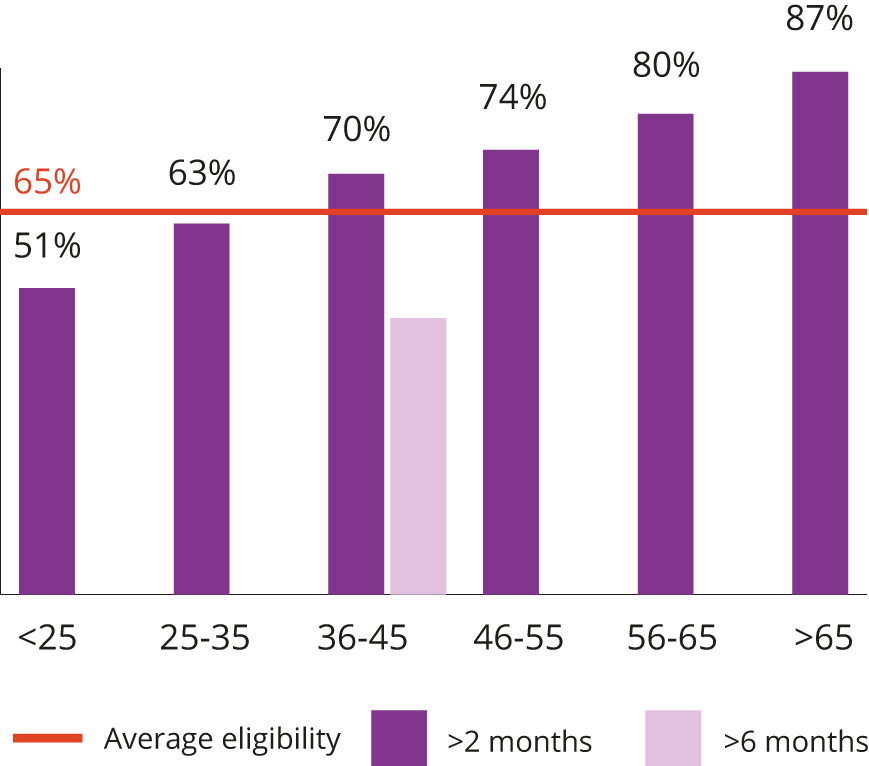Sustainable Employment Commitment
Probably Unfair
Policy Description and Objectives
The Sustainable Employment Commitment (CES) is an exceptional and temporary measure included in the Resolution and Resilience Program (RRP), in which the Government, through the Institute of Employment and Vocational Training (IEFP), provides financial support to employers who hire unemployed workers.
Its objectives are to stimulate the hiring of unemployed people, including young people; support the net creation of jobs; and promote the quality of employment through open-ended contracts.
People Covered

65% of unemployed individuals were eligible to be employed under CES.1
To be considered eligible, individuals need to have been unemployed and registered in the IEFP for at least 2 months (or for at least 6 months if they are in the 36-45 age group).
The additional restriction of 6 months in individuals aged 36-45 reduces the number of eligible unemployed individuals in this particular age group from 70% to 46%.
1 Sources: IEFP, authors calculations – february 2022
Preliminary Assessment
CES can improve the working conditions of younger workers, who are generally in a more precarious situation (lower wages, more likely to be unemployed or have a fixed-term contract), thus reducing intergenerational inequality.
On the other hand, and bearing in mind that the policy aims to remove individuals from medium and long-term unemployment, it may be creating an age-related bias. The average unemployment duration for individuals aged 36 to 45 who are eligible for CES is higher (16 months) than the average for all eligible unemployed individuals (14 months), and is only exceeded by that of individuals over the age of 55.
Additionally, for the measure to be considered fair, it is necessary that workers who have not been employed under the policy are not adversely affected. In this case, the policy might lead to unfair discrimination against individuals aged 36 to 45. The fact that these individuals are required to be unemployed for at least six months to be eligible raises the likelihood of their being discriminated against, to the detriment of the younger and older age groups (who only require two months of unemployment). Thus, in order to assess the intergenerational fairness of this measure, it is vital to verify whether net job creation has occurred.
Firms Survey Results2
63% of the respondents had never heard of the policy. Of those, 36% would have applied had they heard of it.2
If you applied: How likely would you have been to hire the same person if CES did not exist? (%)

81% of the firms that applied revealed that regardless of the existence of CES they would have hired the same individual (or probably hired), which may indicate a low rate of net job creation.
86% of the firms would have offered the same salary.
2 The survey was conducted by the authors to a sample of 1909 companies between November and December 2022
Policy Assessment
1. Does it move Portugal away from its vision of the future?
Probably not – There is not really a forward vision for the country in this area that can be used as a reference.
2. Does it disadvantage any specific age cohort in the population?
Probably yes – If there is no net job creation, the policy may disadvantage those aged 36-45 who have been unemployed for less than six months, as the labour cost of hiring them is higher.
3. Does it disadvantage any generation, current or future?
Probably yes – The policy may disadvantage some individuals in the present, but since it was in place for less than a year, it is unlikely to disadvantage anyone in the future.
4. Does it reinforce the transmission of inequalities across generations?
No – Hiring subsidies are recommended to improve social mobility: children of unemployed parents who obtained employment thanks to hiring subsidies are more likely to complete their schooling.3
5. Does it limit the choices of future generations?
No – CES was in place for less than a year, and its shortcomings can be corrected in subsequent policies.
3 Ruiz-Valenzuela, J. (2020). Intergenerational effects of employment protection reforms. Labour Economics, 62, 101774.
Further Analysis and Recommendations
- Calculate the net job creation rate, using IEFP micro-data, to assess whether individuals aged 36-45 were negatively impacted by the policy’s introduction.
- Communicate this kind of policies better, reduce administrative red tape, and extend the application deadline, in order to attract more applicants and boost net job creation.
- Assess the active labour market policies implemented in Portugal (there is no known assessment, despite almost 50 policies having been implemented in Portugal since 2012), especially hiring subsidies, to better understand the success rate and possible shortcomings.
Project Output files for download here.
Important Note: The word file must be opened before clicking for the first time in the excel.
About Authors




